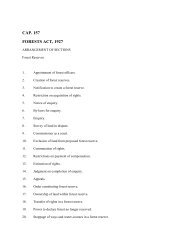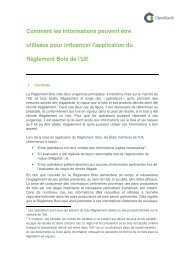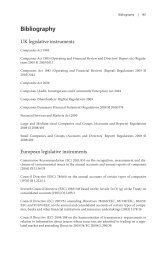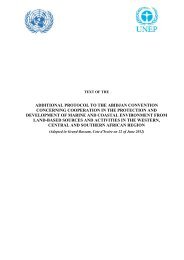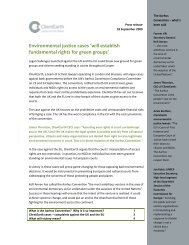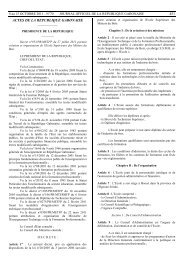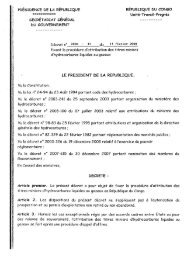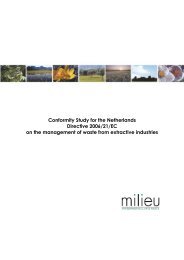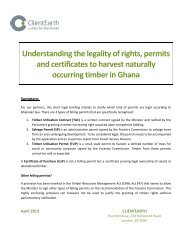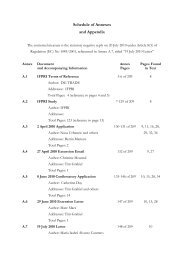Environmental and social transparency under the ... - ClientEarth
Environmental and social transparency under the ... - ClientEarth
Environmental and social transparency under the ... - ClientEarth
- No tags were found...
Create successful ePaper yourself
Turn your PDF publications into a flip-book with our unique Google optimized e-Paper software.
42 | <strong>Environmental</strong> <strong>and</strong> <strong>social</strong> <strong>transparency</strong> <strong>under</strong> <strong>the</strong> Companies Act 2006Chapter 2: The ‘Company Law Review’ | 43reporting practice. It is led by a small coordinating secretariat. Theprimary focus of its work is its ‘Sustainability Reporting Framework’, 125which provides guidance for organisations to use as a basis for disclosureabout sustainability performance, <strong>and</strong> provides a universally-applicable,comparable framework within which to <strong>under</strong>st<strong>and</strong> disclosed information.More than 1,500 companies have declared <strong>the</strong>ir voluntary adoptionof <strong>the</strong> Guidelines worldwide, including many of <strong>the</strong> world’s largest<strong>and</strong> most controversial mining <strong>and</strong> extractives companies such as Shell,Vedanta Resources <strong>and</strong> Anglo American. Therefore, using a voluntaryapproach, <strong>the</strong> GRI has improved <strong>the</strong> amount of environmental <strong>and</strong> <strong>social</strong>information that companies disclose, <strong>and</strong> <strong>the</strong> attention <strong>the</strong>y give to <strong>the</strong>issues. However, <strong>the</strong> extent to which <strong>the</strong> GRI has stimulated reportingwhich gives a true <strong>and</strong> fair reflection of companies, including informationwhich might reflect <strong>the</strong> company in a negative light but which it is necessaryfor shareholders <strong>and</strong> o<strong>the</strong>r users to be party to, should be questioned.Fur<strong>the</strong>rmore, as an aspirational process, ra<strong>the</strong>r than one tied to specificst<strong>and</strong>ards <strong>and</strong> subject to monitoring <strong>and</strong> compliance, it cannot be reliedupon to ensure a high or consistent st<strong>and</strong>ard of <strong>transparency</strong>. None<strong>the</strong>less,it has an important place in <strong>the</strong> overall governance l<strong>and</strong>scape ofcorporate reporting of <strong>the</strong>se issues, one which must be complemented bymore robust <strong>and</strong> unambiguous reporting obligations at national level.The Carbon Disclosure Project ga<strong>the</strong>rs <strong>and</strong> disseminates voluntarily disclosedclimate change data from <strong>the</strong> world’s largest corporations, to inform<strong>the</strong> global market place. It has made considerable progress in engagingcompanies to be transparent about carbon emissions <strong>and</strong> climate changeimpacts. However, as well as remaining a voluntary scheme, <strong>and</strong> thus tosome extent unreliable, it relates only to climate change, not to any of <strong>the</strong>considerable range of o<strong>the</strong>r environmental or <strong>social</strong> issues that companiesneed to report on. Therefore while it has been instrumental in enhancingcorporate disclosure of climate change related data, <strong>and</strong> corporateengagement with <strong>the</strong> issue, it plays but one role in <strong>the</strong> broader spectrumof governance tools that are needed to ensure appropriate corporate <strong>transparency</strong>on environmental <strong>and</strong> <strong>social</strong> issues.The International Accounting St<strong>and</strong>ards Board (IASB) 126 is currentlydeveloping non-m<strong>and</strong>atory guidance for reporting of non-financialforward-looking information. It is aiming to develop principles <strong>and</strong>content requirements to make ‘management commentary’ reporting (<strong>the</strong>equivalent of directors’ reporting) useful to investors. It is expected to becompleted in <strong>the</strong> second half of 2009.Chapter 2:The ‘Company Law Review’ <strong>and</strong> <strong>the</strong> policy<strong>under</strong>pinning <strong>the</strong> Companies Act 20062.1 An overview 432.2 Key concepts in review <strong>and</strong> reform 442.2.1 ‘Enlightened Shareholder Value’2.2.2 Enhancing shareholder engagement <strong>and</strong> dialogueThe Companies Act 2006 was <strong>the</strong> result of a long process of review, knownas <strong>the</strong> ‘Company Law Review’. Key <strong>the</strong>mes <strong>and</strong> policy goals to emergefrom <strong>the</strong> Company Law Review are directly relevant to <strong>the</strong> resultingenvironmental <strong>and</strong> <strong>social</strong> reporting requirements. These policy goalswere restated as priorities by <strong>the</strong> UK government’s White Paper, whichled directly to <strong>the</strong> Companies Act 2006. The need (i) to enshrine in law<strong>and</strong> develop in practice <strong>the</strong> idea of ‘enlightened shareholder value’, <strong>and</strong><strong>the</strong> importance of management’s long-term vision for a company’s success,<strong>and</strong> (ii) to enhance <strong>the</strong> engagement of shareholders with <strong>the</strong> businessof <strong>the</strong> company <strong>and</strong> increase <strong>the</strong>ir dialogue with company management,were seen as central priorities for company law. When read toge<strong>the</strong>r, <strong>the</strong>sepolicy objectives dem<strong>and</strong> effective <strong>and</strong> extensive company reporting ofenvironmental <strong>and</strong> <strong>social</strong> matters. The current lack of clarity in legalobligations for environmental <strong>and</strong> <strong>social</strong> reporting <strong>and</strong> <strong>the</strong> weaknesses in<strong>the</strong> regulatory mechanisms that scrutinise such reporting <strong>under</strong>mine <strong>the</strong>achievement of <strong>the</strong> UK government’s policy objectives.2.1 An overviewThe Company Law Review (CLR) was launched in March 1998 by MargaretBeckett, <strong>the</strong>n Secretary of State for Trade <strong>and</strong> Industry, with <strong>the</strong> publicationof <strong>the</strong> Department of Trade <strong>and</strong> Industry (DTI 127 )’s consultationpaper, ‘Modern Company Law for a Competitive Economy’: 128“[T]he Government commissioned <strong>the</strong> Company Law Review (CLR),an independent group of experts, practitioners <strong>and</strong> business people,to take a long-term <strong>and</strong> fundamental look at our <strong>under</strong>pinning systemof company law, to see how it could be brought up to date.” 129



